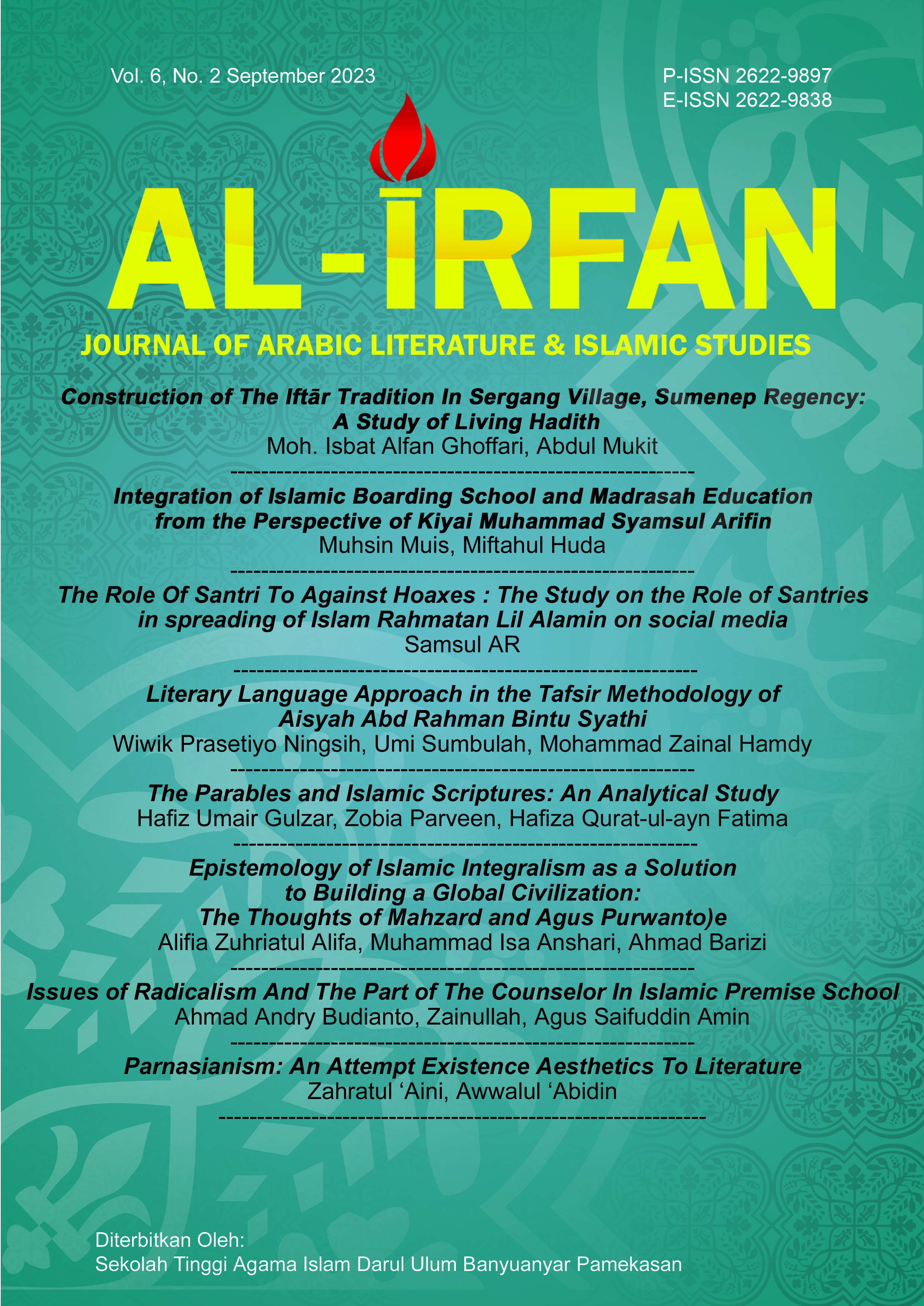Parnasianism: An Attempt Existence Aesthetics To Literature
DOI:
https://doi.org/10.58223/alirfan.v6i2.6896Keywords:
Parnasianism, Existence, LiteratureAbstract
This article discusses one of the sects that emerged in the development of Arabic literature, namely Parnasianism (Barnasiyah). This research aims to discuss matters related to the flow of Parnasianism (Barnasiyah). both in terms of history, figures, vision and mission, urgency, characteristics and examples of application. This research is a descriptive qualitative method, The data collection method used the listening method with a follow up technique, namely the note taking technique. The results obtained from this study are history of the emergence and development of the Parnasianism (Barnasiyah). sect in the second half of the 19th century. The adherents of this sect holds that the most important thing about a work of literature is that its aesthetic is not bound by ethics, morals or religion. Because according to them, the purpose of art is for art itself and nothing else. And one of the figures who realised this flow was Nizar Qabbani in his poem entitled Asy-syaqiqatanReferences
Afifi, R. (1992). Al-Madaris Al-Adabiyyat Al-Aurubiyyah. Dar al-Tibaat al-Muhammadiyah.
Afrizal. (2014). Metode penelitian kualitatif: Sebuah upaya mendukung penggunaan penelitian kualitatif dalam berbagai disiplin ilmu. PT RajaGrafindo Persada.
Al As’ at, I. R. (2022). Aliran Parnasianisme dan Sejarah Perkembangannya. Diwan: Jurnal Bahasa Dan Sastra Arab, 14(2), 90–100.
Bohor, H. (n.d.). ’Atsarul huduri “Al-Barnasiy†fii Tasykili “Qasidatul hubb fii Asy-syi’ir Arabil Mu’asir. Materi perkuliahan di jurusan Madrasah Al-‘Ulya lil Ustazah dalam Bahasa dan Sastra Arab.
Haikal, Y. (2021). Michael Riffaterre̵s semiotic analysis on the poetry Ikbarī’īsyrīna Ᾱman by nizar qabbani. Diwan: Jurnal Bahasa Dan Sastra Arab, 7(2), 172.
Hannay, A. (1954). The Concept of Art for Art’s Sake. Philosophy, 29(108), 44–53.
Kamil, S. (2009). Teori Kritik Sastra Arab Klasik dan Modern. PT Raja Grafindo Persada.
Khalif, T. (n.d.). ’An-Naqd Al-Adaby Al-Hadist Al-Sultony’. Materi Kuliah di Universitas Babilonia. Di akses pada 5 Maret 2023.
Mazhab. (2023). In Al-Ma’ani.
Nirawana, N. (2015). Nirwana dan Cara Pencapaiannya dalam Agama Hindu. Jurnal Al Adyaan; Jurnal Sosial Dan Agama, 1(02).
Qassab, W. (2005). Almazahib Al-Adabiyyah Al-Arabiyyah: Ru’yah Fikriyah wa Fanniyah. Muassasah ar-Risalah.
Ragib, N. (n.d.). Al-Mazhab Al-Adabiyyah minal Klasikiyyah ilal Abassiyah’. Maktabah Ast-saqofiyyah.
Slamet, Y. B. M. (2018). Fungsi dan Peran Karya Sastra dari Masa ke Masa. PRAXIS, 1(1), 24. https://doi.org/10.24167/praxis.v1i1.1609
Sunan, F. R. A. S. U. (n.d.). Aliran Sastra Arab Klasik Sebagai Respon Atas Modernisasi Arab: Kajian Historis.
Whidden, S. (2007). Leaving Parnassus: The Lyric Subject in Verlaine and Rimbaud. BRILL. https://doi.org/10.1163/9789401204460
Downloads
Published
How to Cite
Issue
Section
License
Copyright (c) 2023 Zahratul Aini, Awwalul Abidin

This work is licensed under a Creative Commons Attribution 4.0 International License.
Lisensi :
Al-Irfan: Journal of Arabic Literature and Islamic Studies is published under conditions Creative Commons Attribution 4.0 International License / CC BY 4.0 This license permits anyone to copy and redistribute this material in any form or format, modify, modify, and make derivative works of this material for any purpose, including commercial purposes, so long as they credit the author for the original work.











